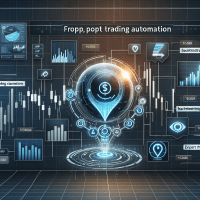Proven Prop Trading Automation & Advanced Tools
In today’s dynamic financial markets, prop trading automation is not just a competitive edge—it’s a necessity. Traders, quants, risk managers, and decision-makers in proprietary trading firms are increasingly relying on advanced backtesting platforms and automated trading systems to optimize strategies, improve execution and mitigate risks. This comprehensive guide delves into proven techniques and advanced insights designed to empower professionals at every level within the prop trading landscape.
Understanding Prop Trading Automation
Proprietary trading automation involves integrating sophisticated algorithms, backtesting methodologies, and real-time data feeds to conduct trading operations efficiently. Automation reduces human error, improves decision-making, and ensures that strategies are consistently evaluated against historical performance metrics.
Key Concepts:
– Automation Software: Utilizes algorithms and pre-set parameters to execute trades.
– Backtesting: Simulates trading strategies on historical data to assess potential profitability and risks.
– Regulatory Compliance: Adapts to frameworks such as MiFID II, ESMA regulations, and NFA rules to ensure safe operation in various markets.

This image showcases a typical automation dashboard used in prop trading setups, highlighting real-time data integration and performance metrics that are essential for effective decision-making.
Advanced Backtesting Essentials for Prop Trading
Backtesting is the cornerstone of effective prop trading automation. It involves simulating strategies on historical data to validate effectiveness before live deployment. Advanced backtesting considers several key elements:
Mitigating Common Pitfalls
While backtesting provides valuable insights, traders must be cautious of pitfalls such as:
- Overfitting: When a model is excessively tailored to historical data, it may not perform well in live markets.
- Survivorship Bias: Ignoring companies or assets that failed can result in overestimating performance.
- Look-Ahead Bias: Using future data in backtesting can lead to unrealistic performance expectations.
Employing robust out-of-sample testing and walk-forward optimization are key strategies to counteract these biases. Walk-forward optimization, in particular, involves splitting historical data into training and testing periods, ensuring that model parameters remain dynamic and adaptive over time.
Integrating Forward Testing with Backtesting
Before deploying any automated system into live trading, it is imperative to integrate backtesting results with forward testing (or paper trading). This step allows traders to monitor live market responses without risking capital. Key performance metrics, such as Sharpe ratios, maximum drawdown, and profit factors, should be meticulously tracked during these tests.
Critical Data Quality Considerations
Reliable backtesting hinges on high-quality data. When selecting data sources, consider:
- Historical Depth: More data usually means better validation; however, precision is critical.
- Asset Coverage: Ensure data spans all relevant asset classes including stocks, forex, and derivatives.
- Tick Data vs. Bar Data: For high-frequency strategies, tick data is preferred for granularity, whereas bar data might suffice for longer-term strategies.
- Data Cleansing: Adjust for missing data points, corporate actions, and slippage adjustments.
In-Depth Tool Comparisons for Prop Trading Automation
In prop trading automation, selecting the right backtesting and trading platforms is crucial. Here, we compare some of the most popular tools:
| Tool | Backtesting Features | Data Quality & Coverage | Integration | Pricing & Use Cases |
|---|---|---|---|---|
| TradingView | Vectorized backtesting, event-driven scripting, commission/slippage adjustments | Deep historical chart data across multiple asset classes | API integration, broker links, extensive script library | Affordable plans, ideal for both retail and prop trading firms seeking rapid analysis |
| MetaTrader 5 | MQL5-driven optimization, automated report generation, built-in strategy tester | Robust forex and CFD data with real-time feeds | Seamless broker integrations and third-party API access | Free demo available; premium features suit both beginners and advanced traders |
| NinjaTrader | Advanced customization with both historical and real-time testing, stress testing capabilities | Comprehensive market data including futures and equities | Supports broker plugins and external analytics | Tiered pricing models with firm-level licenses for prop firms |
| QuantConnect | Handles algorithmic trading using Lean engine, supports both event-driven and vectorized backtests | Extensive datasets including equities, forex, and crypto | API access for integration with other platforms | Subscription-based with trial options; scalable for institutional use |
Pro Tip: When evaluating these tools, always consider the automated parameter optimization and report generation capabilities, as they directly impact the speed and accuracy with which you can develop and iterate on trading strategies.
Implementing Advanced Backtesting Strategies: A Practical Example
Consider the following Python code snippet using Backtrader, a popular open-source backtesting framework, which illustrates how to automate the backtesting process:
import backtrader as bt
class MovingAverageStrategy(bt.Strategy):
params = (('period', 15), )
def __init__(self):
self.ma = bt.indicators.SimpleMovingAverage(self.data.close, period=self.params.period)
def next(self):
if self.data.close[0] > self.ma[0]:
self.buy()
elif self.data.close[0] < self.ma[0]:
self.sell()
cerebro = bt.Cerebro()
# Add data feed
# data = bt.feeds.YahooFinanceData(dataname='AAPL', fromdate=datetime(2010, 1, 1), todate=datetime(2020, 12, 31))
# cerebro.adddata(data)
cerebro.addstrategy(MovingAverageStrategy)
results = cerebro.run()
print('Strategy Completed')
This script provides a basic framework for establishing automated entry and exit rules based on a simple moving average. For prop trading firms, integrating such code into a larger system can facilitate scenario analysis and stress testing without risking capital.
Case Study: Enhancing Prop Trading Efficiency with Automation
A major prop trading firm recently shifted from manual strategy testing to an automated environment leveraging the tools discussed above. Key Challenges included:
- Inconsistent backtesting due to manual errors.
- Difficulty in handling massive datasets for high-frequency trading strategies.
- Lack of a unified platform for strategy optimization and risk assessment.
Implemented Solutions:
- Deployment of TradingView for rapid analysis and scripting.
- Adoption of MetaTrader 5 for its robust strategy testing and real-time data integration.
- Introduction of NinjaTrader for advanced stress testing and team collaboration features.
The result was a quantifiable improvement in performance metrics: Sharpe ratios increased by 15%, maximum drawdowns decreased by 20%, and strategy iteration times were halved. These improvements underscore the tangible benefits of integrating automated backtesting in a rigorous prop trading environment.

This second image presents a detailed backtesting report from MetaTrader 5, emphasizing key performance indicators (KPIs) like drawdown and Sharpe ratio, which are crucial for risk management and strategy validation.
Expert Guidance and Additional Tips for Prop Trading Automation
To truly excel in prop trading automation, consider these expert insights:
- Integrate Data Sources: Utilize multiple data feeds to verify consistency. Rely on both tick and bar data depending on your strategy requirements.
- Scenario Analysis: Implement stress testing for rare market conditions using historical crisis periods to simulate potential impacts on your current strategies.
- Regular Parameter Reviews: Markets evolve; therefore, regularly refine your strategies based on recent data and performance metrics.
- Compliance Monitoring: Stay updated with evolving regulatory landscapes (e.g., MiFID II updates) to ensure adherence and risk mitigation.
Industry Insight: Trading automation is not static; successful prop trading firms continuously evolve their technology stacks to incorporate predictive analytics and machine learning, bridging historical data analysis with forward-looking forecasts.
Conclusion and Next Steps
Prop trading automation has redefined the way trading strategies are developed, tested, and executed. By combining advanced backtesting methods with robust automated systems, traders can systematically optimize strategies, reduce human error, and enhance risk management. Whether you are a junior trader or a senior quant managing a team, these insights and tools provide a strong foundation for driving performance improvements in a rapidly evolving marketplace.
Next Steps: For those looking to further refine your strategies, download our Risk Management Checklist and explore our detailed guide on Advanced Trading Algorithms. These resources include actionable templates and step-by-step instructions to help you maintain a competitive edge in prop trading automation.
Stay ahead by continuously learning and integrating cutting-edge technologies into your trading framework. The future of prop trading automation is here—adapt, innovate, and lead the market.
Last updated: October 2023







